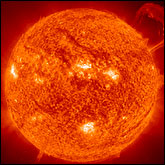Will the Sun Shine Forever?
 The Sun is a huge nuclear furnace. It operates by converting hydrogen into helium. In this process, which is called nuclear fusion, it loses mass and produces energy according to Einstein's famous equation: E=mc^2. This energy is dissipated in the form of light that we see and heat that we feel. In addition, some of this energy comes as X-rays, and a host of accelerated particles.
The Sun is a huge nuclear furnace. It operates by converting hydrogen into helium. In this process, which is called nuclear fusion, it loses mass and produces energy according to Einstein's famous equation: E=mc^2. This energy is dissipated in the form of light that we see and heat that we feel. In addition, some of this energy comes as X-rays, and a host of accelerated particles.
Our Sun has been converting hydrogen into helium for approximately 4.5 billion years. During this period it has converted 25% of its total mass into helium. About 75% of its mass is still hydrogen, and a very small remaining fraction accounts for oxygen, carbon and other elements. Based on a crude extrapolation, one would think that everything would be just fine for at least the next 13.5 billion years; however this is not the case.
The latest estimates show that our Sun will start dying approximately 5 billion years from now. What will happen to it? It will first gradually become brighter; in 5 billion years it will be about twice as bright as it is today. Then the internal energy from the fusion will start decreasing as the hydrogen becomes scarce. Gravity will win and the Sun's core will collapse on itself. This collapse will produce enough heat that the outer layers will expand violently, engulfing Mercury, stripping Venus of its atmosphere and scorching Earth. After this transformation, our Sun will be known as a red giant.
About the Author
Anton Skorucak, MS
 Anton Skorucak is a founder and publisher of ScienceIQ.com. Anton Skorucak has a Master of Science (MS) degree in physics from the University of Southern California, Los Angeles, California and a B.Sc. in physics with a minor in material science from the McMaster University, Canada. He is the president and creator of PhysLink.com, a comprehensive physics and astronomy online education, research and reference web site.
Anton Skorucak is a founder and publisher of ScienceIQ.com. Anton Skorucak has a Master of Science (MS) degree in physics from the University of Southern California, Los Angeles, California and a B.Sc. in physics with a minor in material science from the McMaster University, Canada. He is the president and creator of PhysLink.com, a comprehensive physics and astronomy online education, research and reference web site.


